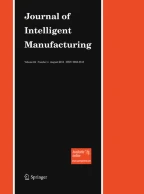This paper describes an object-oriented architecture to support decision making in production scheduling environments. An object-oriented world view is used to integrate concepts from discrete event simulation, conventional scheduling logic and artificial intelligence to produce capacity-feasible schedules. The architecture was implemented as a collection of loosely coupled reusable software objects by extending the functionality of software objects from BLOCS/M (Berkeley Library of Objects for Control and Simulation of Manufacturing). Our experience with an industrial prototype is presented.
Similar content being viewed by others
References
Adiga, S. (1989) Software modeling of manufacturing systems: a case for an object-oriented programming approach. Annals of Operations Research, 17, 363–378.
Chen, P. P. (1976) The entity-relationship model: toward a unified view of data. ACM Transactions on Database Systems, 1(1), 9–36.
Cox, B. J. (1986) Object Oriented Programming - An Evolutionary Approach, Addison-Wesley, MA.
Engelmore, R. and Morgan, T. (1988) Blackboard Systems, Addison-Wesley, Reading, MA.
Fox, M. S. (1986) Industrial applications of artificial intelligence, in Artificial Intelligence in Manufacturing, Bernold, T. (ed), Springer-Verlag, New York.
Fox, M. S. and Smith, S. F. (1984) ISIS - a knowledge-based system for factory scheduling. Expert Systems, 1, 25–49.
Glassey, C. R. and Adiga, S. (1989) Conceptual design of a library of software objects for the simulation of semiconductor manufacturing system. Journal of Object-Oriented Programming, 2(4), 39–43.
Glassey, C. R. and Adiga, S. (1990) Berkeley library of objects for control and simulation in manufacturing, in Case Studies in Object-Oriented Programming, Wiener, R. and Puison, L. (eds), Addison-Wesley, Reading MA.
Hayes-Roth, B. (1985) A blackboard architecture for control. Artificial Intelligence, 26, 251–321.
Hewitt, C. (1977) Viewing control structures as patterns of messages. Artificial Intelligence. 8, 323–364.
King, C. U. and Fisher, E. L. (1989) BARBS: integrating simulation, optimization and knowledge-based techniques to identify and eliminate production bottlenecks. International Journal of Computer Integrated Manufacturing, 2 (6), 317–328.
Kusiak, A. (1987) Designing expert systems for scheduling of automated manufacturing. Industrial Engineering, 19(7), 42–46.
Kusiak, A. and Chen, M. (1988) Expert systems for planning and scheduling manufacturing systems. European Journal of Operational Research, 33(3).
Lin, W-T. (1990) An object-oriented system for knowledge-based production scheduling, Dr. Eng. dissertation, Industrial Engineering & Operations Research Dept., U.C. Berkeley.
Najmi, A. and Lozinski, C. (1989) Managing factory productivity using object-oriented simulation for setting shift production targets in VLSI manufacturing, in Proceedings of AUTOFACT Conference, pp. 3-1 to 3-14.
O'Keefe, R. M. (1985) Expert systems and operational research - mutual benefits. Journal of the Operational Research Society, 36, 125–129.
Phelps, R. I. (1986) Artificial intelligence - an overview of similarities with O.R. Journal of the Operational Research Society, 37, 13–20.
Steffen, M. S. (1986) A survey of artificial intelligence-based scheduling systems, in IIE 1986 Fall Industrial Engineering Conference Proceedings, pp. 395–405.
Stepstone Corporation (1988) Objective-C Reference Manual, Sandy Hook, CT.
Author information
Authors and Affiliations
Rights and permissions
About this article
Cite this article
Adiga, S., Lin, WT. An object-oriented architecture for knowledge-based production scheduling systems. J Intell Manuf 4, 139–150 (1993). https://doi.org/10.1007/BF00123907
Issue Date:
DOI: https://doi.org/10.1007/BF00123907
